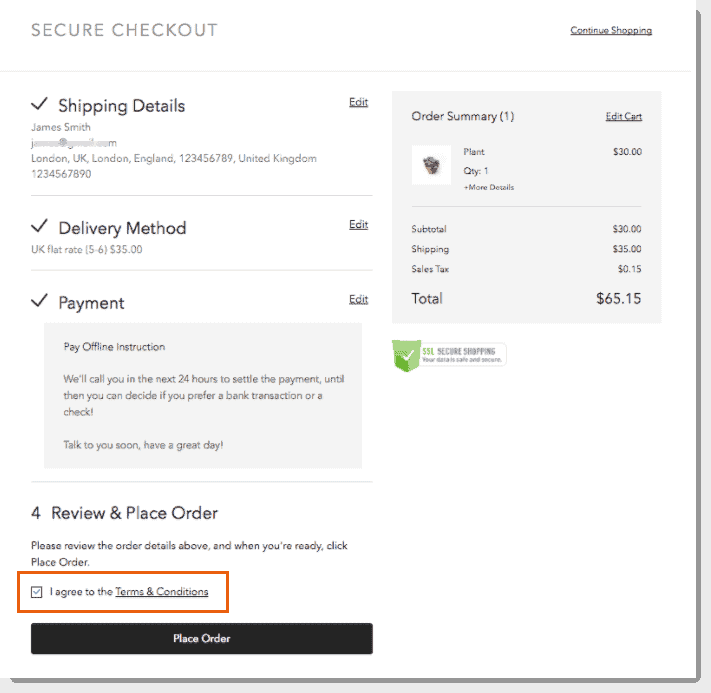In this guide, we discuss a Terms and Conditions Template for eCommerce website owners in 2021…
–
Don’t sell online without website terms and conditions: you’re breaking the law.
It’s all good; I’m going to show you everything you need to tick the T&Cs box for your ecommerce business (in 2021).
We’re going to cover exactly what you need to know so you don’t get caught out.
In short: if you’re looking for a terms and conditions template, you’ll love this guide.
Let’s get started.
What are Website Terms and Conditions of Sale?
Website Terms and Conditions of Sale are the terms you set for customers who purchase products on your website.
They form a legal agreement that customers accept when they place an order through your website.
All of your important terms and conditions for the sale are included, such as payment, delivery, refunds and warranty.

What’s the difference between Website Terms of Use and Website Terms and Conditions of Sale?
There’s an important difference between the two – but you should really have both.
Website Terms of Use are the rules you set out for website visitors and how they interact with the website.
Website Terms and Conditions of Sale are terms specifically for customers who place an order for products on your website.
Some websites combine the two into one document, but we believe it’s better for consumers to leave them as separate legal documents.

Why You Need Them
There are several good reasons why you need them:
It’s a legal requirement in Australia
Under Australian Consumer Law (ACL), you MUST display terms and conditions on your website if you are selling online. ACL gives consumers certain rights and guarantees relating to refunds, repairs or replacement of goods and services. The ACCC can issue fines for websites that are non-compliant.
Protect your business
It’s important to limit your liability and protect against claims relating to the products you sell.
Inform your customers
By clearly stating your terms, your customers will be informed, and it can help avoid complaints down the track relating to refunds, cancellations etc.

What should a Terms and Conditions template include?
There are several different terms and clauses which we recommend you include in your T&Cs:
★ eCommerce – it’s a good idea to confirm that no agreement is formed with a customer until an order has been accepted and processed and an order confirmation has been sent. Stock issues or technical glitches can happen from time to time.
★ Payment – your payment terms, the payment methods accepted etc
★ Refunds – let customers know what your refund procedure is. Remember, you can’t include unfair terms such as “strictly no refunds” as this contravenes Australian Consumer Law.
★ Discounts and Coupon Codes – include any limitations or expiries for discount codes
★ Store Credit – let customers know the procedure and if there are any time limits or limitations
★ Gift Vouchers – let customers know if there are any time limits or limitations
★ Postage and delivery – explain your delivery timeframes, rates, delivery areas etc
★ Australian Consumer Law (ACL) – include consumer guarantees for repairs, replacement, refunds, cancellation etc which can be found here
★ Intellectual Property – clause to protect your intellectual property rights
★ Dispute Resolution – outlines the process to handle any complaints or disputes
★ Severance – an important legal clause
★ Termination – an important legal clause
★ Jurisdiction – outlines the legal jurisdiction (state or territory) governing your terms and conditions and which courts will be used if a legal dispute ends up in court

Australian Consumer Law - what's required?
As mentioned above, you should always include a clause in your T&Cs to cover the consumer guarantees, which are part of Australian Consumer Law.
ACL requires you to include the following details in your Website Terms and Conditions of Sale:
- A statement that you comply with Australian Consumer Law
- How you will provide a refund, repair or replacement of faulty products
- Details of your guarantee
- Details of any warranty (if you provide one, which is not obligatory)
Where should I publish my Website Terms and Conditions of Sale?
Most websites display a tickbox in the checkout with a link to the terms & conditions.
This is also known as a clickwrap (but don’t worry about the fancy name).
Customers must click on “OK“, “I Agree”, or “I Accept” to accept your terms before they place an order.
If you use a common eCommerce platform like Shopify or WooCommerce, they make it super easy to set this up through the settings 🙂.

Can't you just copy them from another website?
Don’t do this.
- This may be copyright infringement, which is against the law.
- You might accidentally copy terms and conditions from another country – if you end up in court for some reason it might be on the other side of the world!
- It won’t be customised to YOUR business. Not a good look for your customers if your info about delivery times is wrong…

Do people actually read T&Cs?
Many people don’t, but you still need them anyway!
They’re mandatory under Australian Consumer Law, so you must display terms and conditions on your website for customers.
Make sure you include a tickbox in your Checkout so that customers are required to accept your terms before they can place an order ✅.
This also means that if they want to read your terms, it’s easy and convenient to do so.

Can I use a free Terms and Conditions generator?
It’s not recommended.
Here are just a few reasons why:
- Most of them are not very good quality and are quite basic
- You can’t be sure that the terms are up-to-date or written for the right jurisdiction
- They may not comply with Australian Consumer Law (ACL)
- You get what you pay for – some free templates are not even written by a lawyer and are unlikely to hold up in a court of law

General Guidelines for Website Terms and Conditions
Here are some tips for best-practice Website Terms and Conditions which are effective and user-friendly:
- Use plain English language (not legal jargon)
- Don’t make them too long
- Make sure your terms are consistent (your refund policy/shipping policy should contain the same information as the relevant sections in your T&Cs)
- Make them fair and reasonable
- Make them easy to find on your website
- Keep them up-to-date!
Do I need a separate Refund Policy page on my website?
No, refunds are already covered in your Terms and Conditions.
However, you might want to add a Refund Policy page to your website to make it easier for customers to find the information.
IMPORTANT: If you decide to add a Refund Policy page, it should mirror the terms you include in your Website Terms and Conditions of Sale.
In other words, the info displayed on your Refund Policy page should be the same as what you have written in your T&Cs.
If you only had a Refund Policy page on your website, a customer could argue that they did not accept the refund policy and are therefore not bound by it.
What if I sell to Australia AND overseas customers?
No worries, you can still cover this in one document. Just make sure you update any relevant sections on payment, shipping, returns etc to include international customers.
Generally you want the governing law for your legal agreements to be where you are based, so that if a dispute arises you are covered by local laws.
Note, if you sell or market to customers in Europe, you will also need a GDPR Privacy Policy to comply with EU privacy laws.
Conclusion
Website Terms and Conditions of Sale are essential for anyone setting up an online store in Australia.
You don’t really have a choice – under Australian Consumer Law, you must display T&Cs on your ecommerce site.
Make sure you sort this out before you start selling!
Need a Website Terms and Conditions Template?
We've Got One!
Visit our Shop and grab it today.



